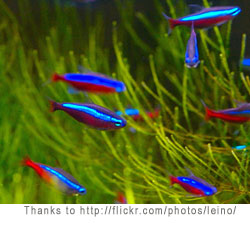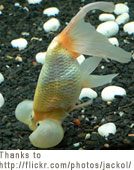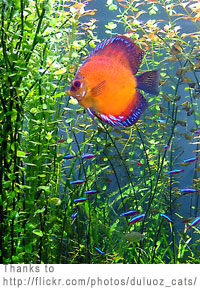Aquarium Advice

Aquarium Frequently Asked Questions
Why is my fish tank cloudy and how can I fix it?
How to fix a cloudy aquarium
If your aquarium is cloudy the first thing he needs check is what color is the cloudiness of your water. The solutions to this problem are different based on color of the cloudiness of your water.click on green aquarium water if your fish tank water is green.
click on cloudy aquarium water if your fish tank water is a whitish color.
A bunch of my fish just died, what should I do?
The very first step if you've lost some of your aquarium fish in a short period of time is to test or water. Water quality is out the utmost importance in keeping your fish alive and healthy your aquarium water clear if the ammonia and nitrite levels are above zero this may be one of the causes of your fish loss/losses. Check if all of the aquarium filter components and the heater are working correctly. Regular aquarium maintenance is the key to the successful long term care of any aquarium if that has been lacking for a period of time that may contribute to fish loss.How to remove an under gravel filter
After you have chosen a new aquarium filter to replace the old under gravel filter. Run the new aquarium filter with the under gravel filter for one month. After one month the new aquarium filter will have a colony of beneficial bacteria growing in it. It will now be safe to remove the under gravel filter.Siphon all of the aquarium water into buckets and transfer the fish into the buckets with the aquarium water. Scoop out the aquarium
 gravel
and remove the under gravel filter. The old aquarium gravel should be rinsed under cool tap water to remove all of the waste. We are not concerned with killing the beneficial bacteria in the gravel
because there is a colony of it growing in the new filter.
gravel
and remove the under gravel filter. The old aquarium gravel should be rinsed under cool tap water to remove all of the waste. We are not concerned with killing the beneficial bacteria in the gravel
because there is a colony of it growing in the new filter. I often replace the gravel instead of rinsing it. Add the gravel back in to the aquarium. Add the water and the fish from the buckets back. Important : Don't replace any of the old water.
Why is it a bad idea to remove all the water and wash the gravel when my fish have become diseased and sick?
Shouldn't this kill the bacteria and sterilize the tank so my fish don't get sick?Microscopic beneficial bacteria live in the filter system, on the top layer of gravel, ornaments and in the aquarium water. Fish need these organisms to live, with out them the water quality will deteriorate causing more problems. By changing all of the water, removing and cleaning the gravel, you kill off the beneficial bacteria. The result will be poor water quality, this leaves the fish prone to stress which is a major cause of disease in freshwater fish. When sick fish are exposed to stressful conditions, it is can be death sentence to them. Changing all the water will shock your fish because you are quickly changing the concentration of elements in the water, fish cannot handle such a sudden change of chemicals and elements and just like sterilizing the gravel, this exposes them to added stress, increasing the likelihood of disease. The best way to cure disease in your fish tank is to treat the whole tank with medicine and do water changes as directed on the package, usually 5% after 3 days and another 10% a week later.
How often should I feed my fish?
 Feed your fish the amount they can consume in a two-minute period. Fish only need to be fed every day or every other day. If you have carnivores in the tank, like a lobster, you must feed him everyday because he will take one of your fish as a snack when he gets hungry! Make sure to watch how much your fish eat when determining the amount to feed them because even after a fish is full, it ill continue to take food in it's mouth. You might think it's eating but a few moments later, the fish will spit out the food. A fish's stomach is only the size of it's eye, keep this in mind when feeding your freshwater fish. Food that goes to waste will rot and cause an ammonia spike in the water, bringing on shock and the possibility of disease and sickness to your whole aquarium. If you are concerned about this or if you have expensive fish that you do not want to risk killing due to over feeding, get a small bottom feeder. A cory cat is the perfect candidate as a bottom feeder fish for your freshwater aquarium. Cory cats are small blunt looking catfish that come in a variety of species, such as the spotted cory... Corydoras are docile and good community fish that can out-swim and hide from more aggressive species of freshwater fish so they are great for the community aquarium and the semi-aggressive aquarium.
Feed your fish the amount they can consume in a two-minute period. Fish only need to be fed every day or every other day. If you have carnivores in the tank, like a lobster, you must feed him everyday because he will take one of your fish as a snack when he gets hungry! Make sure to watch how much your fish eat when determining the amount to feed them because even after a fish is full, it ill continue to take food in it's mouth. You might think it's eating but a few moments later, the fish will spit out the food. A fish's stomach is only the size of it's eye, keep this in mind when feeding your freshwater fish. Food that goes to waste will rot and cause an ammonia spike in the water, bringing on shock and the possibility of disease and sickness to your whole aquarium. If you are concerned about this or if you have expensive fish that you do not want to risk killing due to over feeding, get a small bottom feeder. A cory cat is the perfect candidate as a bottom feeder fish for your freshwater aquarium. Cory cats are small blunt looking catfish that come in a variety of species, such as the spotted cory... Corydoras are docile and good community fish that can out-swim and hide from more aggressive species of freshwater fish so they are great for the community aquarium and the semi-aggressive aquarium.
What is the best kind of filter for my freshwater aquarium?
 There is no single best aquarium filter. The type, size and complexity depend on what size of aquarium you have and how heavily stocked with fish the fish tank will be. Different makes and models of aquarium filter will require varying degrees of maintenance, this should also be a factor in selecting an aquarium filter.
There is no single best aquarium filter. The type, size and complexity depend on what size of aquarium you have and how heavily stocked with fish the fish tank will be. Different makes and models of aquarium filter will require varying degrees of maintenance, this should also be a factor in selecting an aquarium filter.Click on Aquarium Filters for more detailed answers